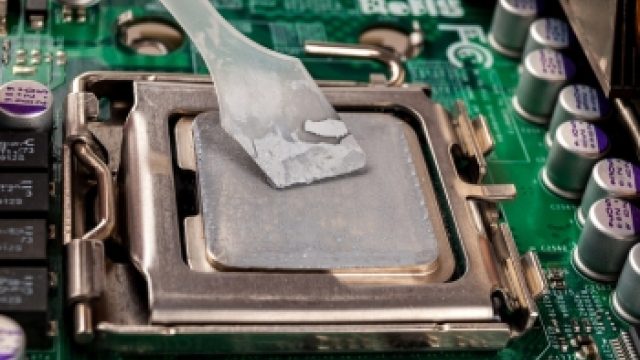Exploring alternative options to thermal paste for cooling your computer components can be tempting, especially in emergency situations. While some household substances like toothpaste or Vaseline might seem like quick fixes, they fall short when it comes to providing optimal thermal conductivity.
In this article, we’ll delve into the world of thermal paste alternatives, discussing their limitations, potential risks, and why using genuine thermal paste is essential for efficient heat dissipation and the overall health of your PC. Let’s uncover the truth behind these makeshift substitutes and make an informed decision for better cooling.
Factors to Consider When Choosing Alternatives
When it comes to thermal management, finding the right thermal paste alternative is crucial for ensuring the optimal performance of electronic components. Thermal paste, often referred to as thermal grease or thermal compound, plays a vital role in facilitating heat transfer between a CPU (Central Processing Unit) or GPU (Graphics Processing Unit) and its heatsink. As we delve into alternative options, let’s first understand the essential properties of thermal paste and the factors to consider when selecting alternatives.
Thermal conductivity is one of the critical properties of thermal paste. It determines how efficiently heat can move from the heat source to the heatsink. High thermal conductivity ensures better heat dissipation, keeping your hardware operating within safe temperature limits.
Viscosity refers to the thickness and consistency of the thermal paste. A paste with the right viscosity is easy to apply and ensures proper coverage, eliminating air gaps between the CPU and heatsink. This factor significantly impacts the overall thermal performance.
Opting for a non-conductive thermal paste is paramount, especially in the case of CPUs and GPUs that have exposed electrical components. Using a conductive thermal paste can lead to short circuits and irreparable damage to the hardware.
Household Items as Temporary Solutions
In dire situations, when you urgently need a thermal paste alternative and can’t access the real deal, certain household items can come to the rescue. However, remember that these alternatives should only be used as a temporary fix until you can obtain proper thermal paste.
Yes, you read that right – toothpaste! It may seem absurd, but toothpaste can act as an unconventional thermal paste substitute for a short period. Its composition includes substances that can aid in heat transfer. However, exercise caution when using toothpaste, as some varieties may contain abrasive particles that could damage the delicate surfaces of your CPU or GPU.
Related Article: How Often Should Thermal Paste Be Changed
Surprisingly, mayonnaise can also serve as a makeshift thermal paste alternative due to its oily and cooling properties. In a pinch, spreading a thin layer of mayonnaise between the CPU and heatsink might help dissipate heat. Nonetheless, be aware that mayonnaise is organic and can pose certain risks, such as unpleasant odors, spoilage, and potential damage to your hardware over time.
Investigating Thermal Pads
Thermal pads are a viable alternative to traditional thermal paste, offering ease of use and reusability in specific cooling scenarios. These soft, compressible pads are typically made of silicone or other thermal conductive materials.
Thermal pads come with the advantage of being pre-cut to fit various CPU and GPU sizes, saving you from the hassle of precise application. Additionally, they are non-conductive, eliminating the risk of short circuits. For scenarios where you may need to swap components frequently, thermal pads are a convenient solution.
Graphite-Based Solutions
Graphite-based thermal paste alternatives have gained popularity for their exceptional thermal conductivity properties. You can find graphite sheets or powders specifically designed for thermal applications.
Related Article: CPU Thermal Pad vs Paste: Maximizing Cooling Efficiency
Graphite, a form of carbon, conducts heat incredibly well. When applied correctly, it can effectively bridge the gap between your CPU and heatsink, facilitating efficient heat transfer. However, take caution during application, as excess graphite can be messy and might cause short circuits if it comes into contact with electrical components.
Thermal Adhesive Tapes
In certain cooling setups, where traditional thermal paste might not be the ideal choice, thermal adhesive tapes step in to save the day. These tapes are double-sided and have adhesive properties on both surfaces.
Thermal adhesive tapes offer practicality in scenarios where the heatsink is challenging to secure using traditional methods. They are particularly useful for compact builds or custom cooling solutions. However, ensure that you choose tapes with appropriate thermal conductivity to meet your specific needs.
The Rice Method
In the realm of unconventional thermal paste alternatives, the “rice method” has emerged as a creative yet risky option. The idea involves placing rice grains between the CPU and heatsink to promote heat transfer.
While this method might seem inventive, it’s vital to exercise caution. Rice lacks thermal conductivity and is not designed for this purpose. It may lead to suboptimal cooling or even cause damage to your hardware.
FAQs About Thermal Paste Alternative
What can I use if I don’t have thermal paste?
If you don’t have thermal paste, you can use alternatives like toothpaste or Vaseline, but they are not recommended for long-term use.
These substitutes may not effectively conduct heat and can lead to improper cooling, potentially damaging your components.
Can I use Vaseline instead of thermal paste?
While Vaseline is a common DIY alternative to thermal paste, it’s not ideal. Vaseline is not designed for conducting heat like thermal paste.
It may work temporarily, but it can dry out, harden, and degrade over time, leading to increased temperatures and potential hardware issues.
Can I use toothpaste instead of thermal paste?
Toothpaste is another makeshift substitute for thermal paste, but it’s not advisable.
Toothpaste lacks the proper thermal conductivity and can dry out, causing poor heat dissipation. It’s best to use genuine thermal paste to ensure your computer components stay adequately cooled.
What is better than thermal paste?
Genuine thermal paste specifically designed for computer components is always the best choice.
High-quality thermal compounds like silver-based or ceramic-based pastes offer superior thermal conductivity, ensuring efficient heat transfer between the CPU/GPU and the heatsink.
Can I make thermal paste at home?
While some DIY thermal paste recipes exist, creating your own thermal paste is not recommended.
The effectiveness and thermal conductivity of homemade pastes are doubtful and might not provide sufficient cooling. Using commercially available thermal paste is a safer and more reliable option.
Is it OK to use a PC without thermal paste?
Using a PC without thermal paste is not recommended. Thermal paste is essential for filling microscopic gaps between the CPU/GPU and the heatsink, facilitating heat transfer.
Running your PC without thermal paste can lead to overheating, which may damage your hardware in the long run.
Does salt help thermal paste?
No, using salt with thermal paste is not beneficial. In fact, it can be harmful. Salt is an insulator and will hinder the thermal conductivity required for proper heat dissipation.
It’s essential to apply thermal paste alone, without any additional substances, to ensure optimal cooling performance.
Can I use my finger to apply thermal paste?
Using your finger to apply thermal paste is not recommended. Fingers can introduce oils and contaminants to the paste, affecting its performance.
Instead, use a plastic spreader or a dedicated thermal paste applicator to achieve an even and clean application.
Is it safe to heat up Vaseline?
Heating Vaseline can be hazardous, as it may release harmful fumes or catch fire. Vaseline is not intended for high-temperature applications, and attempting to heat it for use as a thermal compound is dangerous. Always use appropriate materials designed for computer cooling.
Is thermal paste required?
Yes, thermal paste is crucial for proper cooling of computer components. It fills in microscopic imperfections between the CPU/GPU and the heatsink, ensuring efficient heat transfer.
Without thermal paste, the heat dissipation would be compromised, leading to potential hardware damage.
Does thermal paste expire?
Yes, thermal paste has a limited shelf life. Most commercially available thermal pastes have an expiration date printed on the packaging.
Expired thermal paste may lose its effectiveness and not perform optimally, so it’s best to use a fresh and unexpired product.
How long does thermal paste last?
The longevity of thermal paste varies depending on factors like the brand, type, and environmental conditions.
Generally, high-quality thermal paste can last anywhere from 2 to 4 years before its effectiveness starts to degrade. Regularly replacing old thermal paste can help maintain optimal cooling performance.
Final Thoughts About Thermal Paste Alternative
While thermal paste alternatives like toothpaste or Vaseline might be tempting in a pinch, they are not suitable long-term solutions.
These makeshift substitutes lack the necessary thermal conductivity and can deteriorate over time, leading to inadequate cooling and potential damage to computer components.
It’s crucial to use genuine thermal paste specifically designed for this purpose. High-quality thermal compounds provide superior heat transfer, ensuring efficient cooling and prolonging the lifespan of your hardware.
Taking shortcuts with thermal paste alternatives may save a few bucks temporarily but can ultimately cost you dearly in terms of hardware performance and longevity. Invest in proper thermal paste for a reliable and safe cooling solution.


